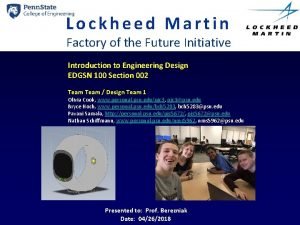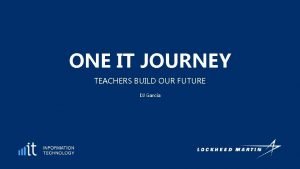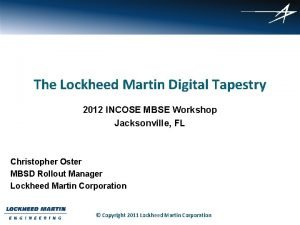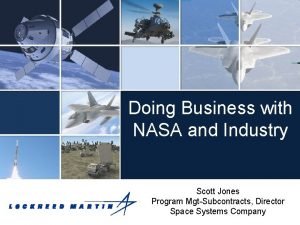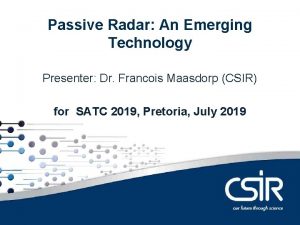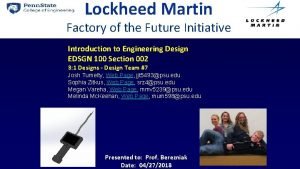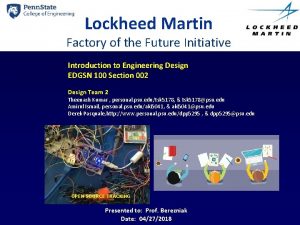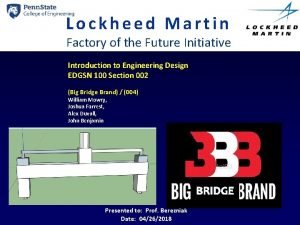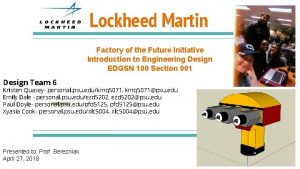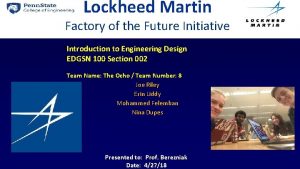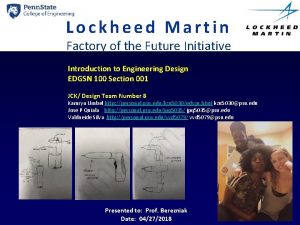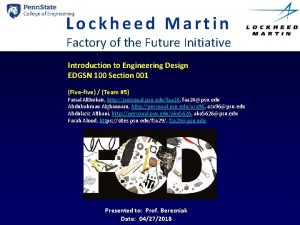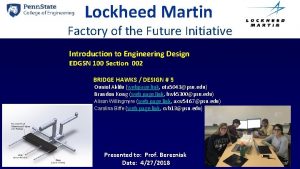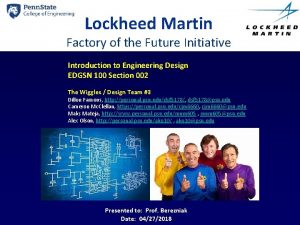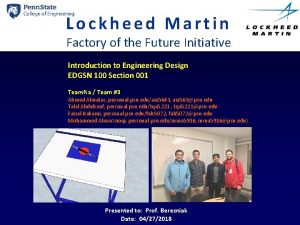Lockheed Martin Factory of the Future Initiative Introduction












- Slides: 12

Lockheed Martin Factory of the Future Initiative Introduction to Engineering Design EDGSN 100 Section 002 BRIDGE HAWKS / DESIGN # 5 Ouniol Aklilu (webpage link, ota 5043@psu. edu) Brandon Kong (web page link, bwk 5300@psu. edu) Alison Willingmyre (web page link, axw 5467@psu. edu) Carolina Biffe (web page link, cvb 13@psu. edu) Presented to: Prof. Berezniak Date: 4/27/2018

Purpose The purpose is to give a brief description of the problem presented and the results we obtained. Through the presentation, we will go over the background information of the problem, a description of the procedure our design team took and the analysis of our final proposed design. 1. 2. 3. 4. 5. 2 Background Project #3 description Design method/ procedure Results Recommendation

Background ❖ Project: #3 Multi-Driver Application ❖ Decision: This project was picked because it fit our groups strengths. ❖ Problem: Lockheed Martin uses circuit units comprised of several circuit cards in their aircrafts. To check or replace one of the units would require the tedious task of unscrewing each screw manually. ❖ Solution: Our team designed a manually operated tool that can unscrew multiple screws at once and adjust to several different situations. ❖ Overall Objective: Create a design for an instrument to enable Lockheed Martin employees to unscrew boxes in a more time efficient manner 3

Sponsor ❖ Project Sponsor: Lockheed Martin ❖ Global security and aerospace company ❖ Headquartered in Bethesda, Maryland with additional locations in over 58 countries worldwide. ❖ Led by CEO and president Marillyn A. Hewson, Lockheed Martin employs upwards of 100, 000. ❖ They cover all aspects of the engineering process (research, design, development, manufacture) in creating advanced designs regarding global security and aerospace design. ❖ Work for National Departments, NASA, intelligence communities, and 70 other governments worldwide. 4

Project Requirements & Description ❖ Project 3: The purpose of this project sponsored by Lockheed Martin was to create an instrument or a device that was cable of unscrewing multiple screw at a time, adjustable to unscrew at any distance apart, easily reconfigured to improve installation and repair times. ❖ Lockheed mentioned the tool will be, mainly, used to unscrew the compartment the circuit cards are in. 5

Project Statement Lockheed Martin uses screws and screwdrivers for many of their circuit card units in their aircrafts. If a single one fails, an engineer will be required to unscrew the top cover to assess the problem. If the engineer needs to unscrew many units, unscrewing each screw individually can be time-consuming and tedious. 6

Design Method 1 Step 1: Understand the specifics of the problem and find background information. Step 2: Brainstorming multiple solutions to the problem. 2 5 Step 3: Select optimal design that fulfills the criteria the best. Step 4: Test the efficiency of the model or simulation. Step 5: This step involves the results and discussion, where the design team presents their model and possible 7 improvements. 4 3

Criteria for Success These conditions are necessary for the product to be easily mass produced and widely used. Benefits of meeting these criteria would be an increase in time efficiency for company employees and, therefore, an increase in company productivity. 8

Procedures ❖ Gained a well-rounded understanding of problems with current solution through research and discussion ❖ Have one central screwdriver operated by a hand crank ❖ Have strap that would turn a parallel screwdriver on either side of the central at the same rate as the central so they unsure in sync ❖ Strap had to be adjustable: velcro was used ❖ Strap had to not slip: rubber was used to maintain a frictional coefficient ❖ Screwdrivers had to be adjustable: gas lift mechanism (found in office chairs) ❖ Solid. Works prototype was created (pictured) ❖ Final realization from prototype was that an additional handle must be added to provide a place where the user can hold the multi-driver device and this was added to prototype 9

Results and Discussion Before 10 After

Conclusions and Recommendations ❖ 11 With a greater budget, our team could create an improved design for this tool. The restriction to simple designs limited our group from some more efficient options. For example, with more money, our group could have come up with a way to motorize the tool. This would make the tool quicker in performance time and with the added power, we could add more screwdriver heads.

Closing Thanks To: 12
 Lockheed martin factory
Lockheed martin factory Lockheed martin cyberquest
Lockheed martin cyberquest Lockheed martin visitor center
Lockheed martin visitor center Lockheed martin code quest
Lockheed martin code quest Lockheed martin marietta
Lockheed martin marietta Lockheed martin visitor center
Lockheed martin visitor center Lockheed martin mbse
Lockheed martin mbse Lockheed martin information systems & global solutions
Lockheed martin information systems & global solutions Lockheed martin investigation
Lockheed martin investigation Scott jacobsen lockheed martin
Scott jacobsen lockheed martin Silent sentry lockheed martin
Silent sentry lockheed martin Lockheed martin houston tx
Lockheed martin houston tx Lockheed martin kill chain
Lockheed martin kill chain
